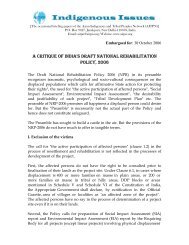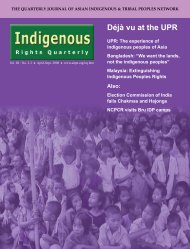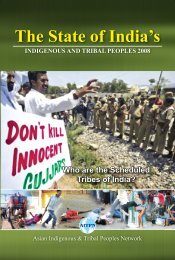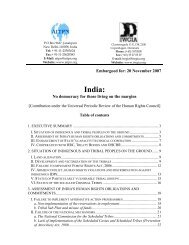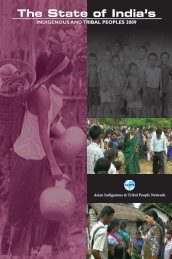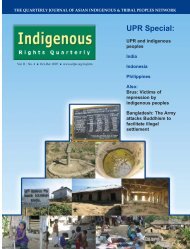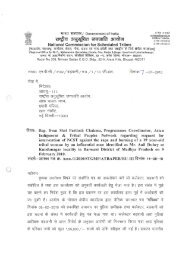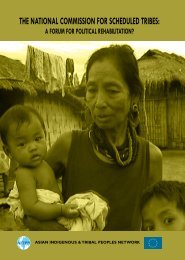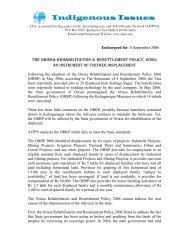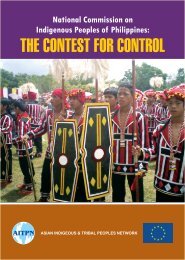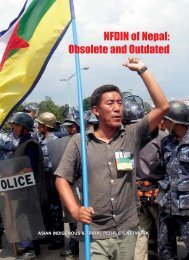india's forest rights act of 2006 - Asian Indigenous and Tribal ...
india's forest rights act of 2006 - Asian Indigenous and Tribal ...
india's forest rights act of 2006 - Asian Indigenous and Tribal ...
- No tags were found...
Create successful ePaper yourself
Turn your PDF publications into a flip-book with our unique Google optimized e-Paper software.
INDIA'S FOREST RIGHTS ACT OF <strong>2006</strong>:Illusion or solution?3initiated with so much fan fare to undo what it calls “historic injustice” thatthe <strong>forest</strong> dwelling Scheduled Tribes have been facing.II. Mixing oranges with applesThe Scheduled Tribes <strong>and</strong> Other Traditional Forest Dwellers (Recognition <strong>of</strong>Forest Rights) Act, <strong>2006</strong> sought to mix oranges with apples. While tribals <strong>and</strong><strong>forest</strong> are synonymous <strong>and</strong> one cannot be separated from the other, same isnot the case with the “other traditional <strong>forest</strong> dwellers” i.e. non tribals.<strong>Tribal</strong>s have emotional, psychological <strong>and</strong> cultural attachments with the<strong>forest</strong> <strong>and</strong> they always lived in the <strong>forest</strong>. On the other h<strong>and</strong>, for non tribal<strong>forest</strong> dwellers, <strong>forest</strong> <strong>and</strong> <strong>forest</strong> related livelihood <strong>act</strong>ivities are the last resortwhen no other options <strong>of</strong> livelihood were left. Non-tribals usually do not takelivelihood <strong>act</strong>ivities in <strong>forest</strong> by choice. However, by legitimising theiroccupation <strong>of</strong> the <strong>forest</strong> l<strong>and</strong>s under the guise <strong>of</strong> “Other Traditional ForestDwellers”, the Act negated the spirit <strong>of</strong> the various safeguards available to themembers <strong>of</strong> the Scheduled Tribes under the Constitution <strong>and</strong> other relevantlaws <strong>of</strong> the country.Rather than improving the lot <strong>of</strong> the tribals, the Act will lead to conflict <strong>of</strong>interest between the <strong>forest</strong> dwelling Scheduled Tribes <strong>and</strong> other traditional<strong>forest</strong> dwellers.III. Extension <strong>of</strong> cut-<strong>of</strong>f dateAnother conspicuous feature <strong>of</strong> the Scheduled Tribes <strong>and</strong> Other TraditionalForest Dwellers (Recognition <strong>of</strong> Forest Rights) Act, <strong>2006</strong> is the extension <strong>of</strong> thecut-<strong>of</strong>f date to qualify for holding <strong>of</strong> <strong>rights</strong> from 25 October 1980 to 13December 2005. At the ground level, the cut <strong>of</strong>f date is quite immaterial to themajority <strong>of</strong> the <strong>forest</strong> dwelling Scheduled Tribes as they have been living inthe <strong>forest</strong> for generations <strong>and</strong> as such they would have been covered evenunder the 25 October 1980 cut <strong>of</strong>f date. This extension <strong>of</strong> the cut <strong>of</strong>f date isbasically to benefit the other traditional <strong>forest</strong> dwellers who are required toprove that they have been occupying the <strong>forest</strong> l<strong>and</strong> for three generationsunder clause (o) <strong>of</strong> Section 2 <strong>of</strong> the Act. By extending the date from 25October 1980 to 13 December 2005, one generation has already been covered!<strong>Indigenous</strong> Issues – The Occasional Briefing Papers <strong>of</strong> AITPN



